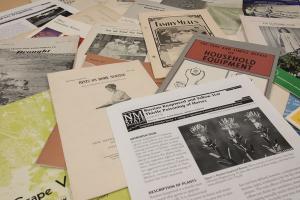
Q. When do I bring my numbered publication to the publishing group?
A. We are glad to help you with any stage of manuscript preparation. You may contact us with questions, plans, or preliminary materials at any time. Otherwise, manuscripts are generally submitted to our unit after a peer review has taken place. Please make sure to send only the final version of the manuscript. For more information, visit: How to Submit a Manuscript for Publication
Q. Would it save time if I lay out a project myself?
A. No. There is no need to try to lay out your project in any desktop publishing program. All we need is a text file or Word document. Any graphics should be provided electronically in separate files as well as in a clean hard copy. Do not attempt to embed any photos or illustrations in the text file.
Q. Will my digital pictures be good enough for print?
A. Yes. Digital pictures must be high-resolution images to work well for print. Recent advances in digital cameras have allowed many of our clients to take high-resolution photos that work very well for print. However, photos should still be clear, well-lit, and in focus. We recommend setting your digital camera at the highest resolution possible. It is better to have a digital file with too much information than one with too little.
Q. Can I use a screen-captured picture from the Web for my print project?
A. Most photos on the Web are 72 pixels per inch (ppi) - this is too low a resolution for a print project. Copyright questions may also arise if a screen-captured picture is used. It is important to understand that the final printed photo will not be of the best quality if such an image is used. We recommend high-resolution digital photos, slides, or actual photo prints for use in print publications.
Q. What is resolution and how does it affect print quality?
A. Resolution is the amount of information or pixels contained in an image. Resolution is measured in pixels per inch (ppi) on monitors, and for print it is measured in dots per inch (dpi) or the number of dots that can be placed side by side in a line one inch long. The higher the resolution, the better quality digital image you will have. What this means for print quality is that if an image is a high-resolution image, there literally are more dots/pixels in every inch of your image and your picture will have that much more detail when printed. Please remember that you can always send us your photos as you take them and we can let you know if they will work for printing.
Q. Where can I find my publications on the Web?
A. College publications are located at http://pubs.nmsu.edu
Q. Do I have to accept all of the changes marked when I get my publication back from the editor?
A. No. The author has final say when it comes to a publication's informational content. Therefore, if the meaning of a sentence has been inadvertently changed by editing, the author should insist that the information be presented accurately. However, the publishing group's editors have final say regarding issues of writing style in order to maintain a consistent and professional series of official college publications.
Q. What style are you following when you edit my publication?
A. When editing college-numbered publications, the Extension / Experiment Station publications group works to maintain a consistent style among publications and support consistent usage within each manuscript. Our guidelines are derived from style recommendations from the American Psychological Association (APA), the University of Chicago Press, and the Council of Science Editors (CSE). Details and explanations can be found in our Author's Guide to Cooperative Extension Service Publications.
When editing a faculty or staff member's manuscript for submission to a peer-reviewed journal, the publishing group editors primarily read for clarity, grammar, spelling, and inconsistencies in the writing style. If you let us know the journal to which you will submit the manuscript, we will take into account their style guidelines. However, we do not intensively edit for individual journal style. Journal editors will apply their own journal's style to articles after they are accepted for publication.
Q. Can I use photos or figures from other sources in my publication?
A. Yes. However, it is the author's responsibility to obtain permission to reprint any material from another publication and to obtain a high-quality electronic file of the material.
Q. Who is the point of contact for communications regarding my manuscript?
A. Communication about production issues will generally be between the publishing group and the primary author of a publication after the manuscript has been submitted for production. It is the responsibility of the primary author to respond to queries about the manuscript and to provide appropriate production materials. If the publishing group does not receive a response to requests about changes to the manuscript, materials necessary for production of the manuscript, or approval of manuscript/proof, the department head and secondary authors will be contacted.
For additional technical information, please visit our Publishing Tips page. We've developed some excellent resources for you - including a webinar that you can view at any time!
Feel free to contact us at any time!
Lee Martínez Soto, Extension Publications Editor
MSC 3K, New Mexico State University
P.O. Box 30001, Las Cruces, NM 88003
Office: 575-646-1174
Fax: 575-646-2099
Email: pubs@nmsu.edu
URL: https://pubs.nmsu.edu


